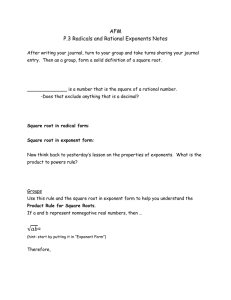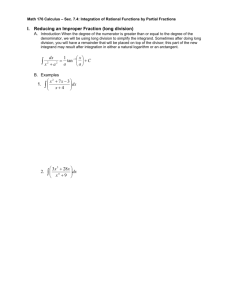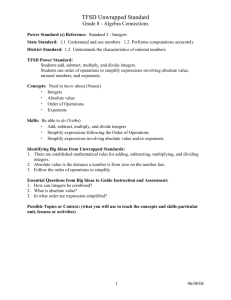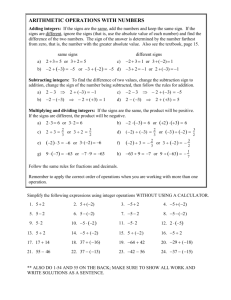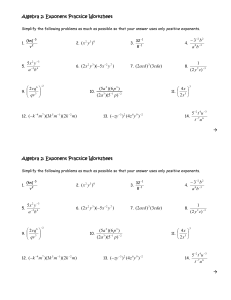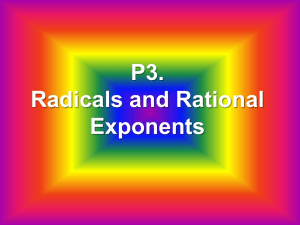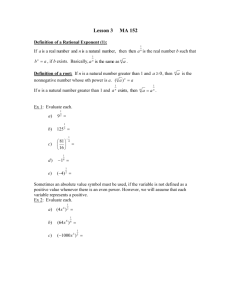Document 10504112
advertisement
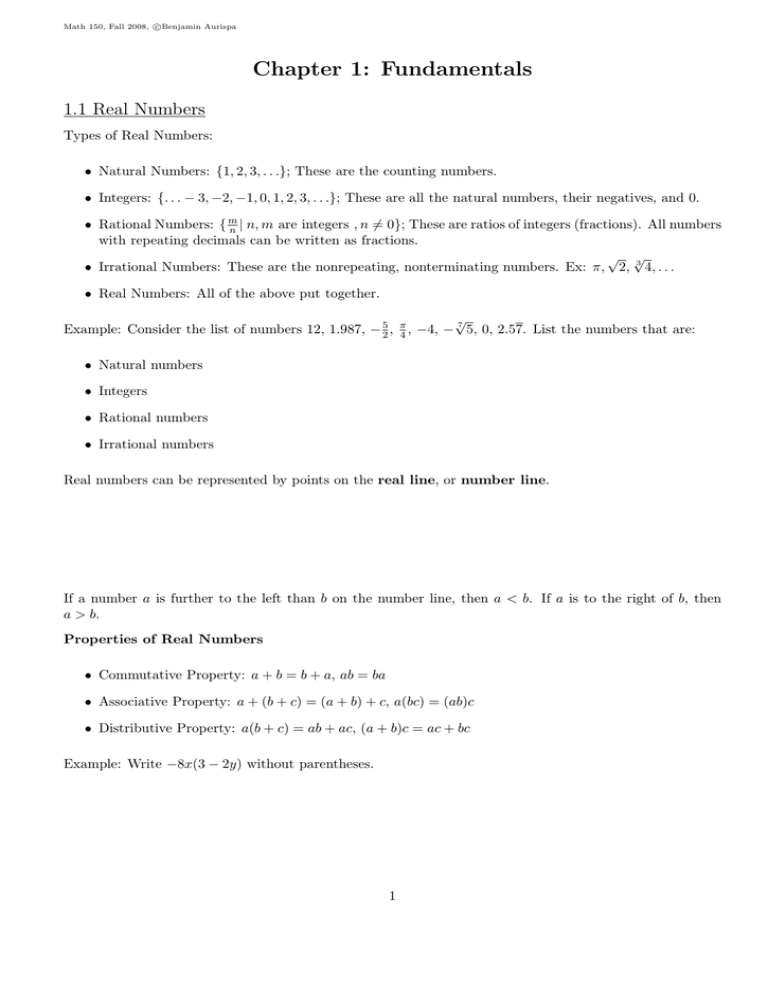
c
Math 150, Fall 2008, Benjamin
Aurispa
Chapter 1: Fundamentals
1.1 Real Numbers
Types of Real Numbers:
• Natural Numbers: {1, 2, 3, . . .}; These are the counting numbers.
• Integers: {. . . − 3, −2, −1, 0, 1, 2, 3, . . .}; These are all the natural numbers, their negatives, and 0.
• Rational Numbers: { m
n | n, m are integers , n 6= 0}; These are ratios of integers (fractions). All numbers
with repeating decimals can be written as fractions.
√ √
• Irrational Numbers: These are the nonrepeating, nonterminating numbers. Ex: π, 2, 3 4, . . .
• Real Numbers: All of the above put together.
Example: Consider the list of numbers 12, 1.987, − 52 ,
π
4,
√
−4, − 7 5, 0, 2.57. List the numbers that are:
• Natural numbers
• Integers
• Rational numbers
• Irrational numbers
Real numbers can be represented by points on the real line, or number line.
If a number a is further to the left than b on the number line, then a < b. If a is to the right of b, then
a > b.
Properties of Real Numbers
• Commutative Property: a + b = b + a, ab = ba
• Associative Property: a + (b + c) = (a + b) + c, a(bc) = (ab)c
• Distributive Property: a(b + c) = ab + ac, (a + b)c = ac + bc
Example: Write −8x(3 − 2y) without parentheses.
1
c
Math 150, Fall 2008, Benjamin
Aurispa
Some Properties of Fractions
1.
a c
ac
· =
b d
bd
2.
a c
a d
÷ = · (Multiply by the reciprocal.)
b d
b c
a b
a+b
+ =
c c
c
a a
a
Note: You can only do this when the fractions have the same denominator: + 6=
b
c
b+c
a
c
4. If = , then ad = bc (Cross multiplying.)
b
d
a
ca
= (Cancel common factors.)
5.
cb
b
3.
To add fractions with different denominators, we have to use the Least Common Denominator.
5
7
Example:
+
12 45
A set is a collection of objects, which are called elements.
Sets of real numbers that make up portions of the number line can be represented by intervals.
A closed interval, [a, b] = {x | a ≤ x ≤ b}; the set of all number between a and b, including the endpoints.
An open interval, (a, b) = {x | a < x < b}; the set of all numbers between a and b, not including the
endpoints.
An interval can also be half-open, half-closed: such as (a, b] or [a, b).
Parentheses indicate that the endpoint IS NOT included. Square brackets indicate that the endpoint IS
included.
2
c
Math 150, Fall 2008, Benjamin
Aurispa
The union of two sets or intervals A and B, denoted A ∪ B, is the set of elements that:
The intersection of two sets or intervals A and B, denoted by A ∩ B, is the set of elements that:
Example: Graph the set (−∞, 7] ∪ [2, 8).
Example: Graph the set [−4, 5] ∩ (1, ∞)
The absolute value of a number x, denoted |x|, is how far x is away from the origin. It is a measure of
distance, so it must always be greater than or equal to 0.
|x| =
Example: |2 − | − 12|| =
|π − 4| =
The distance between two points a and b is: d(a, b) = |b − a| or equivalently |a − b|.
Example: Find the distance between the numbers −4 and − 19
4 .
3
c
Math 150, Fall 2008, Benjamin
Aurispa
1.2 Exponents and Radicals
Exponent Rules
1. an = a · a · a · . . . · a
2. a0 = 1, for a 6= 0
3. a−n =
1
an ,
for a 6= 0
4. am an = am+n
5.
am
an
= am−n
6. (am )n = amn
7. (ab)n = an bn Note: This only works with multiplication. (a + b)n 6= an + bn
an
bn
8. ( ab )n =
9. ( ab )−n = ( ab )n
10.
a−n
b−m
bm
an
=
Examples: Simplify and write without negative exponents.
4
2
• (4x y)
•
x
3y 2
xy −2 z −3
x2 y 3 z −4
3
!−2
4
c
Math 150, Fall 2008, Benjamin
Aurispa
Radicals
√
The symbol
means “the positive square root of”.
√
To find a, find the number b such that b2 = a. In all cases (except when a = 0), there are two numbers b
that make this true. The answer is the POSITIVE one.
Similarly, to find
√
3
In general, to find
a, the cube root (or third root) of a, find the number b such that a = b3 .
√
n
a, find the number b such that bn = a.
• If n is EVEN, we must have a ≥ 0 and b ≥ 0.
• If n is odd, there are no restrictions.
Does
Does
√
a2 always equal a?
√
3
a3 always equal a?
So, we define
√
n
an =
Simplify the following expressions:
•
q
(−7)18 x6 y 12
•
q
(−4)15 r10 s25
6
5
5
c
Math 150, Fall 2008, Benjamin
Aurispa
Properties of Radicals
1.
2.
3.
√
n
ab =
q
n
a
b
=
q√
m
n
√
√
n
anb
√
na
√
n
b
a=
√
mn
a
Examples: Simplify these expressions
1.
2.
3.
4.
√
4
25
√ √
6 15
q
3
27
64
√
√
32 + 128
Note: It is NOT true that
√
a2 + b2 = a + b.
All these properties follow from properties of exponents when we use the following:
√
n
a = a1/n
√
√
n m
a = am/n = ( n a)m
This means that ANY radical can be written using rational exponents.
Examples:
1. Calculate 363/2
2. Calculate 48−3/4
6
c
Math 150, Fall 2008, Benjamin
Aurispa
3. Simplify the following and write without negative exponents. Assume all variables represent positive
numbers.
8x−5/2 y 6
54z 3
!−2/3
√
4. Write the following as a single power of x:
√
x· 4x
√
( 5 x)2
We rationalize the denominator in order to get any radicals out of the denominator. We do this by
multiplying top and bottom by an appropriate factor.
Examples
•
√2
5
3
• √
5
x3
7
